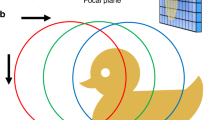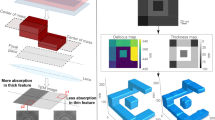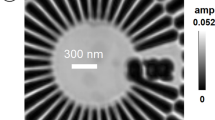Abstract
Technical advances paired with developments in methodology have enabled electron microscopy to reach atomic resolution. Further improving the information limit in microscopic imaging requires further improvements in methodology. Here we report a ptychographic method that describes the object as the sum of discrete atomic-orbital-like functions (for example, Gaussian functions) and the probe in terms of aberration functions. Using this method, we realize an improved information limit of microscopic imaging, reaching down to 14 pm. High-quality probes and objects contribute to superior signal-to-noise ratios at low electron doses, allowing for relaxation of the sample thickness restriction to 50 nm for dense materials. Additionally, our method has the capability to decompose the total phase into element components, revealing that the information limit is element dependent. With enhanced spatial resolution, signal-to-noise ratio and thickness threshold compared with conventional ptychography methods, our local-orbital ptychography may find applications in atomic-resolution imaging of metals, ceramics, electronic devices or beam-sensitive material.
This is a preview of subscription content, access via your institution
Access options
Access Nature and 54 other Nature Portfolio journals
Get Nature+, our best-value online-access subscription
$29.99 / 30 days
cancel any time
Subscribe to this journal
Receive 12 print issues and online access
$259.00 per year
only $21.58 per issue
Buy this article
- Purchase on Springer Link
- Instant access to full article PDF
Prices may be subject to local taxes which are calculated during checkout




Similar content being viewed by others
Data availability
All data that support the findings of this study have been deposited in Zenodo52.
Code availability
The code needed to evaluate the conclusions in this article are available on request from the corresponding author.
References
Williams, D. B. & Carter, C. B. Transmission Electron Microscopy (Springer, 2009).
Haider, M. et al. A spherical-aberration-corrected 200kV transmission electron microscope. Ultramicroscopy 75, 53–60 (1998).
Chen, Z. et al. Electron ptychography achieves atomic-resolution limits set by lattice vibrations. Science 372, 826–831 (2021).
Hoppe, W. Beugung im inhomogenen Primärstrahlwellenfeld. I. Prinzip einer Phasenmessung von Elektronenbeungungsinterferenzen. Acta Crystallogr. A 25, 495–501 (1969).
Miao, J., Charalambous, P., Kirz, J. & Sayre, D. Extending the methodology of X-ray crystallography to allow imaging of micrometre-sized non-crystalline specimens. Nature 400, 342–344 (1999).
Rodenburg, J. M. Ptychography and related diffractive imaging methods. Adv. Imaging Electron Phys. 150, 87–184 (2008).
Zheng, G., Shen, C., Jiang, S., Song, P. & Yang, C. Concept, implementations and applications of Fourier ptychography. Nat. Rev. Phys. 3, 207–223 (2021).
Pfeiffer, F. X-ray ptychography. Nat. Photonics 12, 9–17 (2017).
Nellist, P. D., McCallum, B. C. & Rodenburg, J. M. Resolution beyond the ‘information limit’ in transmission electron microscopy. Nature 374, 630–632 (1995).
Maiden, A. M., Humphry, M. J., Zhang, F. & Rodenburg, J. M. Superresolution imaging via ptychography. J. Opt. Soc. Am. A 28, 604–612 (2011).
Humphry, M. J., Kraus, B., Hurst, A. C., Maiden, A. M. & Rodenburg, J. M. Ptychographic electron microscopy using high-angle dark-field scattering for sub-nanometre resolution imaging. Nat. Commun. 3, 730 (2012).
Pelz, P. M., Qiu, W. X., Bucker, R., Kassier, G. & Miller, R. J. D. Low-dose cryo electron ptychography via non-convex Bayesian optimization. Sci. Rep. 7, 9883 (2017).
Ophus, C. Four-dimensional scanning transmission electron microscopy (4D-STEM): from scanning nanodiffraction to ptychography and beyond. Microsc. Microanal. 25, 563–582 (2019).
Ding, Z. et al. Three-dimensional electron ptychography of organic-inorganic hybrid nanostructures. Nat. Commun. 13, 4787 (2022).
Gao, W. et al. Real-space charge-density imaging with sub-angstrom resolution by four-dimensional electron microscopy. Nature 575, 480–484 (2019).
Kohno, Y., Seki, T., Findlay, S. D., Ikuhara, Y. & Shibata, N. Real-space visualization of intrinsic magnetic fields of an antiferromagnet. Nature 602, 234–239 (2022).
Zachman, M. J. et al. Mapping pm-scale lattice distortions and measuring interlayer separations in stacked 2D materials by interferometric 4D-STEM. Microsc. Microanal. 28, 1752–1754 (2022).
Rodenburg, J. M. & Bates, R. H. T. The theory of super-resolution electron microscopy via Wigner-distribution deconvolution. Phil. Trans. R. Soc. Lond. A 339, 521–553 (1997).
McCallum, B. C. & Rodenburg, J. M. Two-dimensional demonstration of Wigner phase-retrieval microscopy in the STEM configuration. Ultramicroscopy 45, 371–380 (1992).
Chapman, H. N. Phase-retrieval X-ray microscopy by Wigner-distribution deconvolution. Ultramicroscopy 66, 153–172 (1996).
Pennycook, T. J., Martinez, G. T., Nellist, P. D. & Meyer, J. C. High dose efficiency atomic resolution imaging via electron ptychography. Ultramicroscopy 196, 131–135 (2019).
O’Leary, C. M. et al. Phase reconstruction using fast binary 4D STEM data. Appl. Phys. Lett. 116, 124101 (2020).
Gao, C. et al. Overcoming contrast reversals in focused probe ptychography of thick materials: an optimal pipeline for efficiently determining local atomic structure in materials science. Appl. Phys. Lett. 121, 081906 (2022).
Elser, V. Phase retrieval by iterated projections. J. Opt. Soc. Am. A 20, 40–55 (2003).
Rodenburg, J. M. & Faulkner, H. M. L. A phase retrieval algorithm for shifting illumination. Appl. Phys. Lett. 85, 4795–4797 (2004).
Thibault, P. et al. High-resolution scanning X-ray diffraction microscopy. Science 321, 379–382 (2008).
Maiden, A. M. & Rodenburg, J. M. An improved ptychographical phase retrieval algorithm for diffractive imaging. Ultramicroscopy 109, 1256–1262 (2009).
Maiden, A. M., Humphry, M. J. & Rodenburg, J. M. Ptychographic transmission microscopy in three dimensions using a multi-slice approach. J. Opt. Soc. Am. A 29, 1606–1614 (2012).
Sha, H., Cui, J. & Yu, R. Deep sub-angstrom resolution imaging by electron ptychography with misorientation correction. Sci. Adv. 8, eabn2275 (2022).
Sha, H. et al. Ptychographic measurements of varying size and shape along zeolite channels. Sci. Adv. 9, eadf1151 (2023).
Sha, H. et al. Sub-nanometer-scale mapping of crystal orientation and depth-dependent structure of dislocation cores in SrTiO3. Nat. Commun. 14, 162 (2023).
Dong, Z. et al. Atomic-level imaging of zeolite local structures using electron ptychography. J. Am. Chem. Soc. 145, 6628–6632 (2023).
Zhang, H. et al. Three-dimensional inhomogeneity of zeolite structure and composition revealed by electron ptychography. Science 380, 633–663 (2023).
Cowley, J. M. & Moodie, A. F. The scattering of electrons by atoms and crystals. I. A new theoretical approach. Acta Crystallogr. 10, 609–619 (1957).
Allen, L. J., Alfonso, A. J. D. & Findlay, S. D. Modelling the inelastic scattering of fast electrons. Ultramicroscopy 151, 11–22 (2015).
Odstrcil, M. et al. Ptychographic coherent diffractive imaging with orthogonal probe relaxation. Opt. Express 24, 8360–8369 (2016).
Das, S. et al. Observation of room-temperature polar skyrmions. Nature 568, 368–372 (2019).
Veličkov, B., Kahlenberg, V., Bertram, R. & Bernhagen, M. Crystal chemistry of GdScO3, DyScO3, SmScO3 and NdScO3. Z. Kristallogr. 222, 466–473 (2007).
Lee, D. et al. Emergence of room-temperature ferroelectricity at reduced dimensions. Science 349, 1314–1317 (2015).
Gao, P. et al. Atomic mechanism of polarization-controlled surface reconstruction in ferroelectric thin films. Nat. Commun. 7, 11318 (2016).
Kirkland E. J. Advanced Computing in Electron Microscopy (Springer, 2020).
Jurling, A. S. & Fienup, J. R. Applications of algorithmic differentiation to phase retrieval algorithms. J. Opt. Soc. Am. A 31, 1348–1359 (2014).
Odstrcil, M., Menzel, A. & Guizar-Sicairos, M. Iterative least-squares solver for generalized maximum-likelihood ptychography. Opt. Express 26, 3108–3123 (2018).
Pelz, P. M. et al. Phase-contrast imaging of multiply-scattering extended objects at atomic resolution by reconstruction of the scattering matrix. Phys. Rev. Res. 3, 023159 (2021).
Uhlemann, S. & Haider, M. Residual wave aberrations in the first spherical aberration corrected transmission electron microscope. Ultramicroscopy 72, 109–119 (1998).
Krivanek, O. L., Dellby, N. & Lupini, A. R. Towards sub-Å electron beams. Ultramicroscopy 78, 1–11 (1999).
Schwiegerling, J. Review of Zernike polynomials and their use in describing the impact of misalignment in optical systems. In Proc. Optical System Alignment, Tolerancing, and Verification XI (eds Sasián, J. & Youngworth, R. N.) 103770D (SPIE, 2017); https://doi.org/10.1117/12.2275378
Bertoni, G. et al. Near-real-time diagnosis of electron optical phase aberrations in scanning transmission electron microscopy using an artificial neural network. Ultramicroscopy 245, 113663 (2023).
Paszke, A. et al. PyTorch: an imperative style, high-performance deep learning library. In Proc. 33rd International Conference on Neural Information Processing Systems (eds Wallach, H. M., Larochelle, H., Beygelzimer, A., d'Alché-Buc, F. & Fox, E. B.) 721 (Curran Associates, 2019).
Burdet, N. et al. Evaluation of partial coherence correction in X-ray ptychography. Opt. Express 23, 5452–5467 (2015).
Nellist, P. D. & Rodenburg, J. M. Beyond the conventional information limit: the relevant coherence function. Ultramicroscopy 54, 61–74 (1994).
Yang, W., Sha, H. & Yu, R. 4D datasets used for local-orbital ptychographic reconstruction [data set]. Zenodo https://doi.org/10.5281/zenodo.10246206 (2023).
Acknowledgements
R.Y. was supported by the National Natural Science Foundation of China (52388201, 51525102). For this work we used the resources of the Physical Sciences Center and Center of High-Performance Computing of Tsinghua University.
Author information
Authors and Affiliations
Contributions
R.Y. supervised the project, conceived the idea and designed the research. W.Y. wrote the codes with the help of H.S. and L.M. W.Y. and H.S. performed experiments. J.C. performed simulations. W.Y. and R.Y. co-wrote the paper. All authors discussed the results and commented on the paper.
Corresponding author
Ethics declarations
Competing interests
The authors declare no competing interests.
Peer review
Peer review information
Nature Nanotechnology thanks William Bowman, Yu Han and the other, anonymous, reviewer(s) for their contribution to the peer review of this work.
Additional information
Publisher’s note Springer Nature remains neutral with regard to jurisdictional claims in published maps and institutional affiliations.
Extended data
Extended Data Fig. 1 Reconstruction via the LOP method on simulation datasets of SrTiO3.
a and b, The probe amplitude and the object potential used to generate the simulation 4D-dataset; c and d, The probe amplitude and the object phase reconstructed via the LOP method; Scale bars in a-d, 2 Å.
Extended Data Fig. 2 Experimental diffraction patterns.
a and b, The PACBED and a single CBED for the dataset of SrTiO3; c and d, The PACBED and a single CBED for the dataset of DyScO3.
Extended Data Fig. 3 The diffraction patterns of simulation datasets.
a, The position-averaged convergent beam electron diffraction (PACBED) with respect to different electron dose; b, The single CBED with respect to different electron dose.
Extended Data Fig. 4 Amplitude of initialized probe function in LOP for the dataset of DyScO3.
All aberrations are at zero, except for a defocus value of 20 nm. Scale bar, 5 Å.
Extended Data Fig. 5
Phase of initialized object function in LOP for the dataset of DyScO3.
Extended Data Fig. 6 Ptychography reconstruction results on an experimental dataset of a thick (50 nm) sample of SrTiO3.
a and b, Probe amplitude; c and d, object phase. The LOP reconstruction converged well, but the CPP reconstruction did not. The first probe mode is shown; Scale bars in a-d, 4 Å.
Extended Data Fig. 7 Reconstructed probe on experimental datasets.
a and b, Probe reconstructed via the LOP and CPP methods for the dataset of DyScO3; c and d, Probe reconstructed via the LOP and CPP methods for the dataset of SrTiO3.
Rights and permissions
Springer Nature or its licensor (e.g. a society or other partner) holds exclusive rights to this article under a publishing agreement with the author(s) or other rightsholder(s); author self-archiving of the accepted manuscript version of this article is solely governed by the terms of such publishing agreement and applicable law.
About this article
Cite this article
Yang, W., Sha, H., Cui, J. et al. Local-orbital ptychography for ultrahigh-resolution imaging. Nat. Nanotechnol. (2024). https://doi.org/10.1038/s41565-023-01595-w
Received:
Accepted:
Published:
DOI: https://doi.org/10.1038/s41565-023-01595-w



